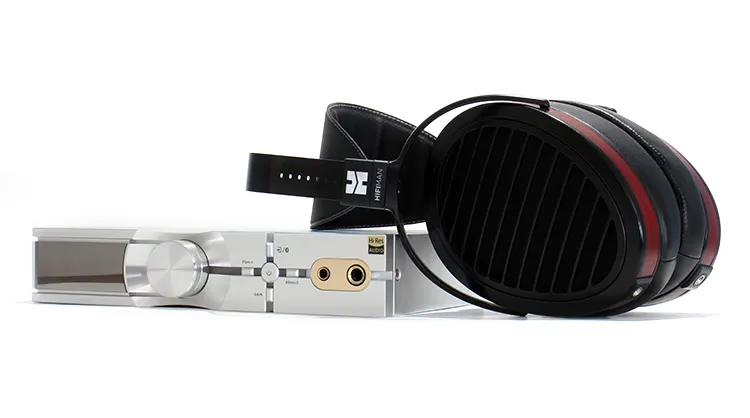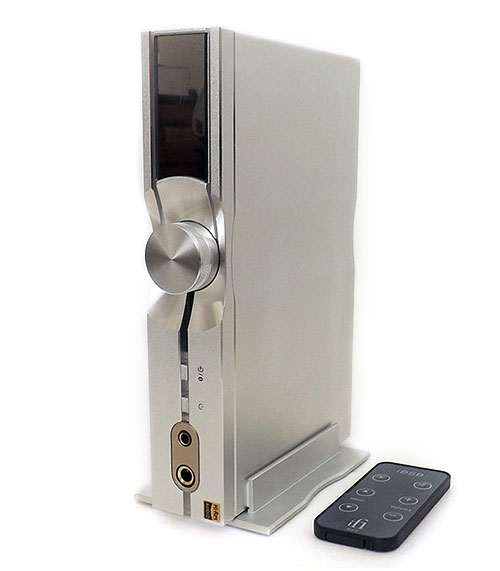Sound Impressions
My listening sessions consisted of pairing the NEO iDSD 2 with the HIFIMAN Arya Organic, the Dekoni Audio Blue, and the Meze Audio 99 Classics for headphones along with some FiiO FD7, FH15, and the HIFIMAN Svanar IEMs.
The digital filters were set to standard and the sound-shaping features were disabled to obtain a neutral and flat as possible presentation.
Summary
The iFi Audio NEO iDSD 2 has a sound output general characteristic that can be described as being composed of the high power output capability in amplification of the Diablo 2 joined together with the smooth characteristics of their ZEN ONE Signature.
The general sound presentation is neutral with a hint of warmth, a full spectrum frequency response that’s well extended both ways and a dynamic presentation that’s punchy and wide sounding, especially when you engage all the sound tuning features.
The vocal presentation has lots of presence and is at times inward and personal. But what grabs the listener is the realism that is characteristically produced.
One aspect that carried over from the original NEO is the silent operation. There’s no hiss, turn on or turn off thump, no operational noise, and no switching noise. Just a slight bump when you engage the Xbass feature.
Staging and Dynamics
The iFi Audio NEO iDSD 2’s overall sonic attack is reduced from the iDSD Diablo 2 for example and they’re more in line with the ZEN ONE Signature which is smooth and not too hot sounding. It perfectly displays the warmth of the Burr Brown DACs and offers up a homely presentation.
The overall staging is done in an orderly manner in which not much conglomeration takes place and separation is distinct.
One of the features that help the soundstage occupy more space is the Xspace feature but the NEO iDSD 2 also offers up a presence feature that is activated either separately or in conjunction with the Xbass feature that adds forwardness.
Synergy
Power
The iFi Audio NEO iDSD 2 has a peculiar but remedial volume control. The differences between the three top gain levels change suddenly but the largest change takes place when you drop the gain down to the iEMatch level. I would only use this setting with very sensitive IEMs.
Somehow it seems that the available power amount is a reserved one that only hits the higher specification numbers when at very high volume levels. Perhaps that improves if the NEO iDSD 2 is used with a 15-volt wall wart instead of the 12-volt included wall wart.
One specification veered my thoughts on power output. If you look at the specifications it seems that the amplifier stage has a higher propensity to produce voltage versus wattage. But the current rating is not posted.
A quick Ohm’s law formula calculation can give you the amount and if you do, the numbers tell a story of an amplifier that although equipped with a balanced output, does not produce double the power but a small and modest gain on the balanced output compared to the single-ended output.
Pairings
When a DAC/amplifier combo or any component includes sound shaping tools like digital filters and the Xbass/ Xspace feature, the overall sonic presentation is flexible because of this feature set.
That versatility allows a wider range of cans to be used and produce a proper and enjoyable performance level. For example, if you use a bass-heavy can, just leave the settings off. But most are bass-light or neutral.
Some are deficient in soundstage size, so just engage the Presence and the Xspace feature.
For example, some of HIFIMAN’s headphones tend to benefit from the added bass when you engage the Xbass feature. Not so much with a can like the Meze Audio 99 Classics which sounds great with neutral settings.
Select Comparisons
All the comparisons were done using a single pair of HIFIMAN’s Arya Organic headphones with balanced OFC cables. Both unit’s gain settings were set to the highest setting and the DAC filters were set to NOS or standard.
iFi Audio NEO iDSD
Technical
The original upright iFi Audio NEO iDSD was a hit because it was an excellent choice for a center hub due to its versatile IO and silent operation.
The included remote controls of both models give the user armchair control but the NEO iDSD 2 steps it up with the inclusion of the Lexis app that lets you access all the features from a mobile phone.
Add to that more power, Xbass/Xspace/ presence sonic tuning features, and the updated 5.4 Bluetooth and all that combined puts the original NEO clearly in second place.
Design
The two NEO models use the same chassis but the NEO iDSD 2 has additional buttons up front, and the headphone connection faceplate has a gold-plated flare. The TFT color display is just frosting on the cake.
Both models use the same volume control and knob. Both feel smooth and raise volume in a balanced manner and there seems to be no volume channel imbalance that I could detect, especially when the NEO iDSD 2 is on the IEMatch setting within the system menu.
Performance
My favorite way of using the original NEO is as a DAC and an audio control center hub but I tended to rarely use the amplification section except on occasions when I was using a sensitive IEM. But most of the time I would use it with a separate amplifier. The NEO excels in this aspect.
The DAC section consists of iFi’s customized Burr brown variants and both these models share similar sonic characteristics if you compare them in the digital conversion realm. Both share a list of digital formats and BT codecs except for the added aptX Lossless capability of the NEO iDSD 2.
Bluetooth 5.4 hasn’t taken off In a sense since there are only a handful of mobile devices that are capable of functioning at that codec level. If you still run LDAC then you will not notice any difference in performance between the two in that area.
Where you see the big gain is in the additional Xbass/Xspace/ presence features, the addition of the color display with an ample menu full of features, and the five-fold additional power output capability.
HIFIMAN EF600
Technical
Let’s call this comparison the battle of the two towers. Both these models offer vertical mounting, but only the NEO gives you the choice of horizontal mounting.
The HIFIMAN EF600 is a large tower that is simple in appearance and doesn’t offer many features and it certainly doesn’t come with any sound-shaping capabilities. It does offer clean, unaltered sound from the source, that’s what it does best.
Design
The HIFIMAN EF600 is a large tower indeed and it takes over your visual senses on any desktop. The cabinet is made from a long, thick brushed aluminum slab, folded into a U-shape and fitted with a polymer shell that also acts as a headphone stand.
The rounded surface on top won’t dent your headband and although the NEO iDSD 2 is large enough to be used as a headphone stand the sharp edges will leave an undesired mark on most headbands so I suggest getting a separate headphone stand if you get the NEO iDSD 2.
The overall quality of the EF600 cabinet design is excellent. However, the one caveat is the volume knob itself. Not only is there a large amount of play on the shaft, but it’s also rectangular and it resembles a stove knob.
They should have used the round knob from the EF400 which is smooth in operation, just as the volume knob on the NEO iDSD 2.
Other aesthetic issues come to mind. For example, the EF600 has a rear-mounted power button but the NEO iDSD 2 has it upfront which is more convenient.
Performance
If you compare raw power exclusively, the EF600 seems to have more power on tap, and this could be attributed to the massive power supply it has within the massive cabinet plus it uses a direct AC connection instead of a wall wart. The con is that the EF600 produces more heat.
Sonically, the EF600 might come across as the more musical-sounding of the two. They both produce a clean translation and have a high ability to squeeze details out of digital files. The NEO iDSD 2, however, produces a warmer bottom end.
My other major observation was within the soundstage. The NEO iDSD 2 can produce a taller and wider sound especially if you engage the Xspace but in stock form, the EF600 might take the lead by a nose in width particularly.
However, considering the size of the cabinet and the lack of features compared to the NEO iDSD 2, plus the mounting versatility and combination of sound tuning features, the above might throw off the balance on purchase day.
Bluetooth performance goes to the NEO iDSD 2 as well since it has the updated 5.4 radio capable of receiving an aptX Lossless signal that surpasses all other codecs when it comes to sheer performance and sonic quality production. But if you’re like me and stuck on LDAC you could go either way.
Our Verdict
The iFi Audio NEO iDSD 2 is what the NEO iDSD should have been all along.
The extra power on tap is a most welcomed implementation. Add to that the Xbass, Presence, and Xspace, plus all the IO and you have a formidable AIO that gives the potential buyer a lot to think about.
The NEO iDSD 2 also operates and performs all its tasks silently. Aside from all the trinkets, that and its sonic abilities are its best traits.
Only a top model stack or an esoteric setup can surpass the iFi Audio NEO iDSD 2 sonically and in features and I honestly have nothing negative to say about it.
iFi Audio NEO iDSD 2 Technical Specifications
- Inputs: USB 3.0 (USB 2.0 compatible)SPDIF, Optical
- Bluetooth 5.4: aptX Lossless, aptX Adaptive, aptX, LDAC, HWA/LHDC, AAC and SBC
- Clock: External sync clock 10mHz 1Vpp nominal, 75Ω. Sinewave or Squarewave
- Format: PCM 768kHz, DSD512 (22.6mHz), MQA full decoder
- Line output. Balanced 19.5v max, (Variable 4.4 fixed) / Unbalanced 10.5v max ( variable 2.2v fixed)
- Output impedance: XLR ≤100Ω / RCA ≤50Ω
- SNR: 120db (A) @ 0 dbfs
- DNR: 120db (A) @ 60 dbfs
- THD-N: ≤0.0015 @ 0 dbfs
- Headphone out: Bal 4.4mm 3.5V / 19.5V max (12Ω -600Ω)
- Headphone out: Unbalanced 6.35mm / 4.5V / 9.50V max (12Ω -300Ω)
- Max output power: Balanced ≥5V / 650mW (@600Ω), ≥ 13.3V / 5551mW (@32Ω)
- Max output power: Unbalanced ≥5V / 184mW (@600Ω), ≥9.5V /2832mW (@32Ω)
- RMS output: Balanced ≥3V / 620mW (@600Ω), ≥ 12.7V / 2530mW (@64Ω)
- RMS output: Unbalanced ≥9.75V / 157mW (@600Ω), ≥4V /1390mW (@64Ω)
- Output impedance: 1Ω
- Power supply requirements: DC9V / 1.5A – 15V /0.9A (centre +ve)
- Dimensions: 214 x158 x 41 mm (8.4” x 6.2” x 1.6”)
- Net weight: 916g ( 2.0lbs)









